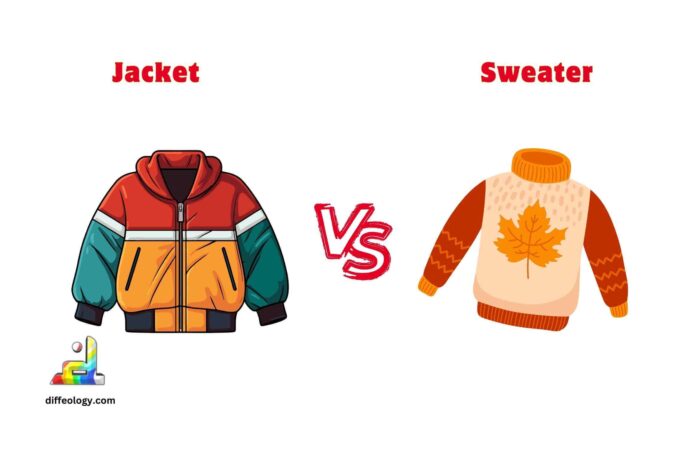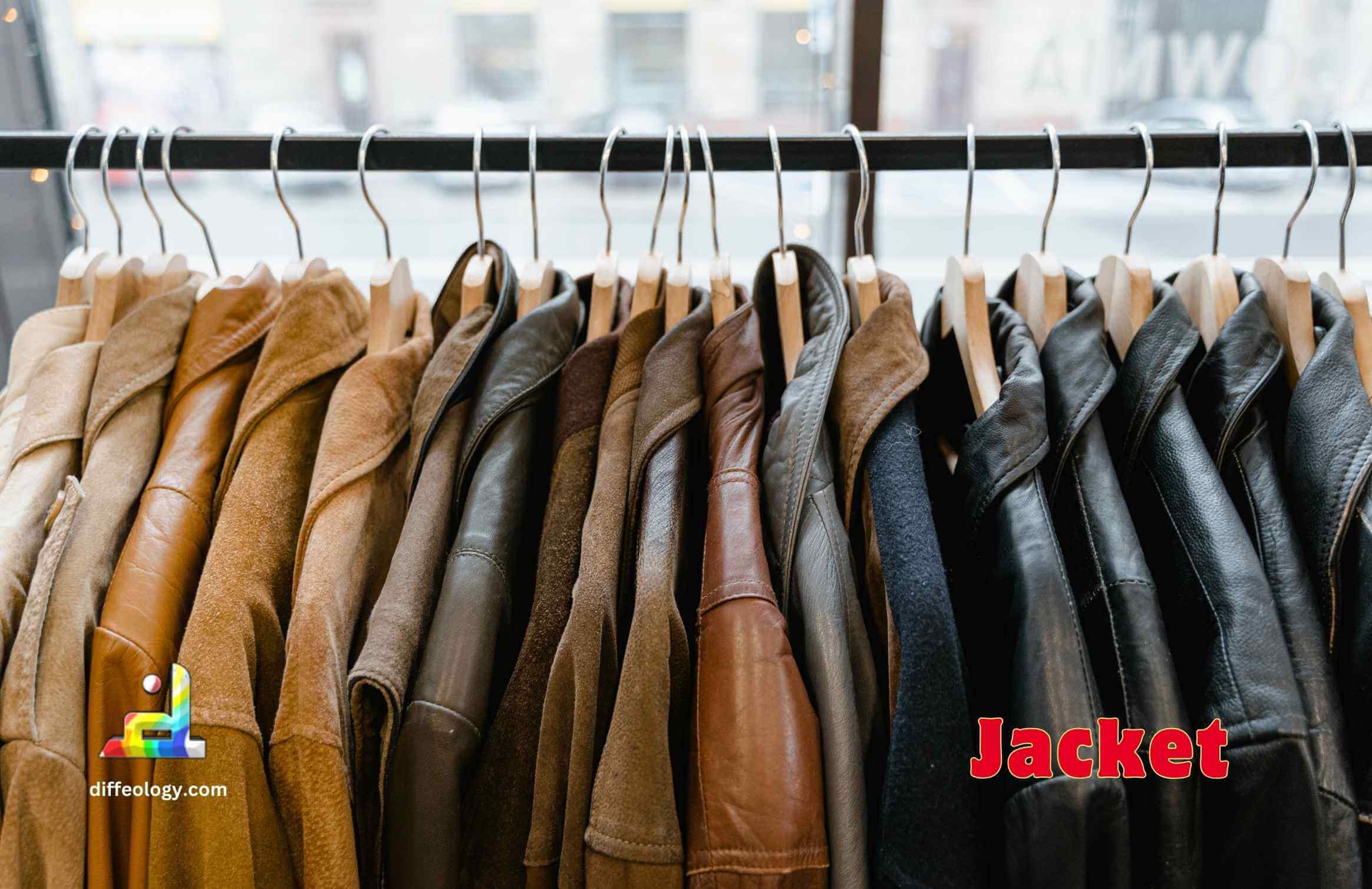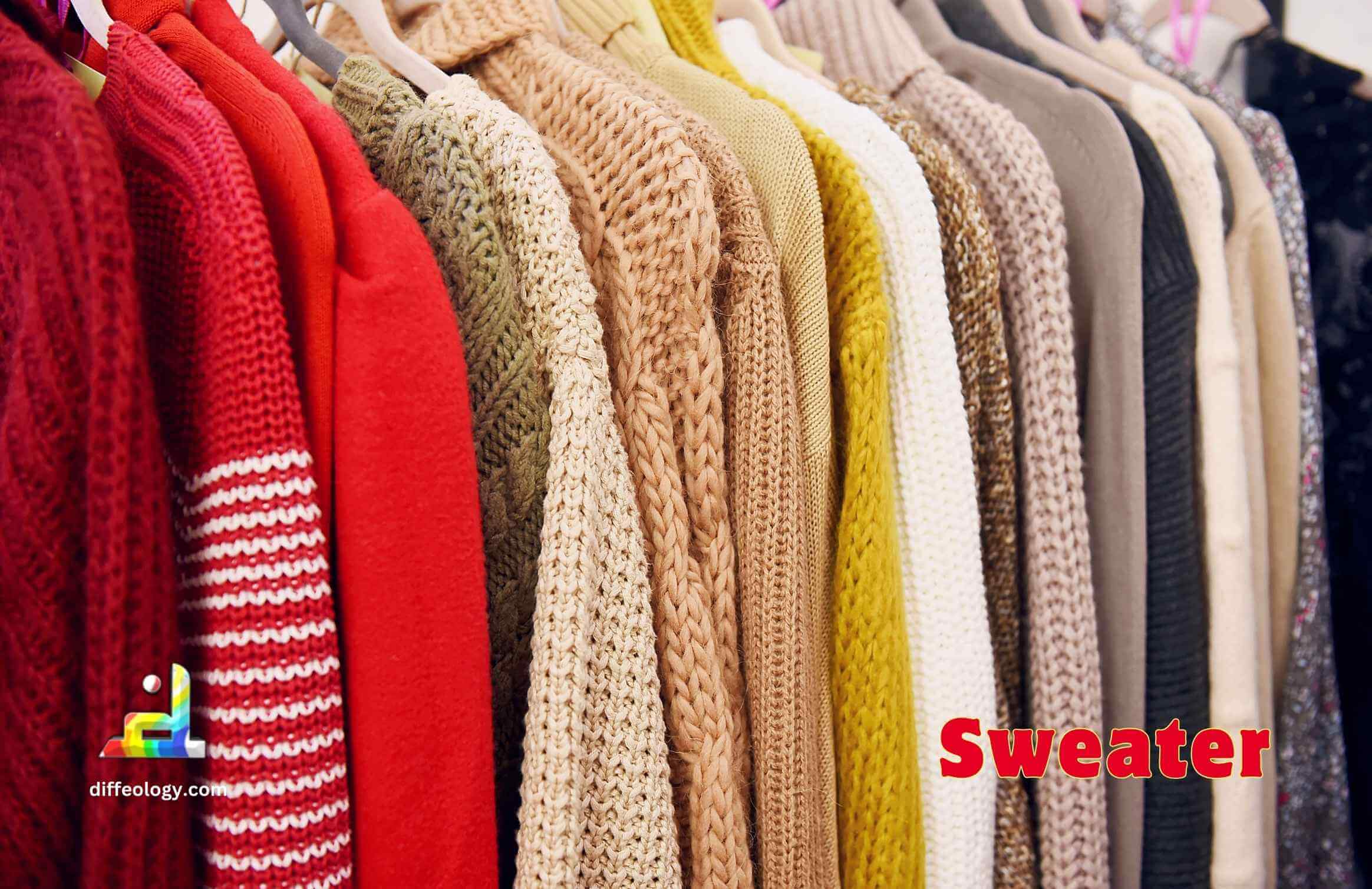The Difference between Jacket and Sweater is obvious. A jacket and a sweater, to me, are outerwear but for two completely different purposes. The jacket is usually made out of heavier materials, such as leather or synthetic ones, made for protection from the wind, rain, or the cold. Jackets generally contain zippers or buttons and can be layered over other types of clothing.
A sweater is normally made with softer materials like wool or cotton. It is worn for warmth, especially when it is cold. Sweaters do not usually have zippers and are instead pulled over the head. They are designed to be more about warmth and comfort indoors. Understanding these differences can help you choose the right clothing for the weather and occasion.
Main Difference Between Jacket and Sweater
Jackets are generally made of thick, water-resistant materials; either it is leather or nylon. Sweaters are soft, warm, and made from wool or cotton. Jackets are mainly used to avoid the wind and rain and to keep the cold intact. Sweaters are basically used to make you warm but are seldom waterproof. Jackets usually consist of a zipper or buttons in the front, so they can be easily removed. Sweaters are usually put over the head, with no zippers or buttons. A jacket is an outer garment, usually worn over other garments. Whether the sweater serves as inner or outer clothing depends on the weather.
Jacket Vs. Sweater
What is a Jacket?
A jacket is a garment worn on the upper part of the body. Jackets normally have very long sleeves and are most often worn layered over clothing for warmth or protection. Jackets are common to wear during the colder parts of the year, including winter or fall. Styles vary from denim to leather to waterproof jackets. Some jackets have front closures by means of zippers or buttons, and pockets can also be seen. Jacket thickness differs due to the fact that, while some are very light, like windbreakers, other jackets, like winter jackets, are designed with heavier material in them in order to sustain higher body warmth.
Read Also: Difference Between Jumpers and Cardigans
Jackets can be practical, but also a style of fashion. People wear various kinds of jackets according to the function or occasion. For example, for fashion reasons, other times people would put on leather jackets, and then there are rain jackets for protection against the rain. Jackets are highly popular throughout the world and generally represent the culture and regional weather of a particular area. The global jacket market was estimated to be around $50 billion in 2022, which portrays the importance of this type of clothing globally.
What is a Sweater?
A sweater is a garment designed to warm you up and is usually worn over the torso. It is made from materials like wool, cotton, or synthetic fibers. Sweaters are more common for application during cold weather to add extra warmth. You can wear it over shirts or other layers. Some of the most common kinds of sweaters are pullovers; you pull these sweaters over your head and cardigans, which provide a front opening like any other jacket. Sweaters differ in neck styles, like crewnecks, V-necks, or even turtlenecks.
Read Also: Difference Between Toboggan Hat and Beanie
Sweaters have long been popular. Wool sweaters became in high demand during the 1800s. They first became quite popular with people in cold areas such as Europe. Wool is a natural insulator that retains the warmth of a person’s body. Today, there are countless styles and colors of sweaters for the latest trends in the fashion industry. In the U.S., an average sweater will be priced at around $20 to $100, depending on the material and brand. Not only do they help keep one warm, but they are also a fashion statement. Most people wear them layered while wearing either jeans or skirts.
Comparison Table “Jacket Vs. Sweater”
| Material | Often made of heavier fabrics | Usually knitted or woven |
| Weight | Generally heavier | Generally lighter |
| Purpose | Provides warmth and style | Provides warmth and comfort |
| Closure | Often has zippers or buttons | Usually open or pullover |
| Fit | Can be fitted or loose | Often fitted and cozy |
| Layers | Worn over other clothing | Can be worn alone or layered |
| Weather | Good for wind and rain | Good for cool temperatures |
| Style | More formal or sporty | Casual and relaxed |
| Sleeves | Typically has long sleeves | Usually has long sleeves |
| Variety | Many styles (bomber, denim) | Various types (crew, turtleneck) |
| Occasion | Suitable for outings | Good for home or casual events |
| Care | Often requires special washing | Usually machine washable |
| Fashion | Trendy and stylish | Classic and timeless |
| Breathability | Can be less breathable | More breathable |
| Durability | Often more durable | Can wear out faster |
| Pockets | Often includes pockets | Rarely has pockets |
| Temperature | Better for colder, windy days | Ideal for chilly, indoor use |
| Versatility | Can dress up an outfit | Pairs well with jeans |
| Price | Can be more expensive | Generally more affordable |
| Occasion Fit | Works for both casual and formal | Best for casual settings |
| Style Trends | Changes often with fashion | Often stays classic |
Difference Between Jacket and Sweater in Detail
Get to know the Difference Between Jacket Vs. Sweater in Detail.
Material
Jackets are covered with tougher, weather-resistant fabric. It could be from leather, denim, and synthetic fabrics. These are covered in jackets so that people are protected from the wind and rain. The stronger the materials that jackets are covered in, the colder it may get, and it would be suitable for harsher weather. Some have linings inside jackets, which give extra warmth. This is very helpful for people to be dry and comfortable outdoors.
Sweaters are normally soft and light, either in the form of wool, cotton, or acrylic. These are to keep warmth and assure warmth retention on the body. However, they aren’t made to repel raindrops or withstand a gust of wind. It is mainly used in lighter weathers or under an overcoat for layering. Sweaters are also very light and comfortable indoors in most settings.
Thick vs. Thin
Jackets are made thick enough to face the most unfavorable weather conditions. Thick material and extras in hoods or high collars stop the wind and rain from being felt. This makes them suitable for wearing in cold, windy, or rainy climatic conditions. Many people wear jackets for outdoor purposes or in places that get very cold for a certain period of each season.
Sweaters are better suited for less drastic climates that value warmth rather than protection against rain or snow. They breathe well and are comfortable, often dressed during the fall or early winter months. A sweater is perfect for indoor settings or on those chilly days when you need a little light warmth without the extra bulk.
Style and Occasion
Jackets are outerwear; hence, jackets can be casual or formal. A leather jacket looks very good with cool and rugged looks; in contrast, a blazer is mostly formal wear. Jackets also often have zippers, buttons, or belts to help show more style. Thus, they serve the purpose not only as a fashionable addition to many outfits but also functionally.
Sweaters are much more casual; however, sometimes they can be worn semi-formally, depending on the style. Sometimes, they can also be pullovers, cardigans, or even turtlenecks. Ultimately, the basic idea is that sweaters are a little more comfortable than many other garments, and people favor them just because of warmth and the cozy feeling rather than making some style statements.
Layering Capability
Jackets are meant to be layered over other clothes, thus making them an ideal layering piece. Underneath one can wear a T-shirt or a sweater for added warmth as long as it doesn’t overwhelm the over-layered outer loose-fitting jacket which would be perfect for most cold weather conditions.
Sweaters are typically layered between a T-shirt and a jacket. They are closer fitting, so it is difficult to layer one over another unless the outer layer is loose-fitting. Normally, sweaters are not layered over jackets, so they have less flexibility for layering.
Durability
They are much more durable compared to jackets since they use tougher materials like leather or synthetic fibers. Jackets tend to last longer since they are made to stand upright outside. Depending on the quality of a particular jacket, such as a high-quality leather or denim one, it can last for years if cared for properly.
However, sweaters are made of softer fabrics. They can wear out faster. Wool and cotton can shrink, pill, or stretch with time; therefore, sweaters are generally more delicate. There is a better way in which care can be taken of the sweater-by hand washing or other special methods of laundering to retain their shape and texture over time.
Weight and Comfort
Jackets are heavy because they are made of materials and more extra layers of protection. For example, leather jackets weigh several pounds; winter coats are bulky. Therefore, jackets are weighty, a kind of which may even be tight if left for long.
In this regard, sweaters are relatively light because they are made up of softer materials compared to many other garments like wool or cotton. Such lightness makes them so fond for long wearing especially indoors. Most people put on their sweaters if only there is a need to warm up without having the weight around their bodies attributed to heavy clothing.
Breathability
Jackets, especially when made of synthetic or waterproof material, tend to trap much heat and sweat inside of them; hence they are less breathable than sweaters. Some jackets do have vents or breathable materials in them; however, as a whole, they are more protective than comfortable.
Sweaters are breathable clothes because they are made from natural fibers like wool or cotton. Wool, for example, regulates body heat because it keeps you warm and allows sweat to evaporate outside your body. Therefore, sweaters are more comfortable when you want to feel warm but do not want to get too hot and sweaty at the same time.
Price Range
Jackets are generally more expensive, especially if they are made of superior materials such as leather or down. A good leather jacket or an insulative winter jacket may run several hundred dollars. In return, the jacket provides protection and durability of the superior use of weather protection.
Sweaters are less expensive. While some wool or cashmere sweaters can be quite expensive, most sweaters are a less expensive crop cash-wise as they are made of cotton or acrylic and the like. Therefore, they prove to be very affordable for everyday use compared to jackets.
Seasonality
Jackets are usually used during autumn, winter, or early spring when it gets more cold and uncertain. They are very essential for people in wintry climates as they protect them from the elements. Some of the lighter jackets could be used even for cool summer evenings, but in general, they are a warm weather product.
Compared to many other layers, sweaters tend to be used more seasonally. While they may be primarily reserved for cooler months, they are light enough for use in early fall or late spring. Some very lightweight sweaters can even be worn on summer nights. However, they wouldn’t be used for extreme cold unless layered under a jacket.
Key Difference Between Jacket and Sweater
Here are the key points showing the Difference Between Jacket Vs. Sweater.
Weight Jackets tend to be heavier because of the materials used. Sweaters are generally lighter and softer.
Season Jackets are commonly worn in the fall and winter but also on rainy days in spring. Sweaters are mostly worn in winter or cooler fall days.
Design Jackets come in various designs, including bomber jackets, blazers, and denim jackets. Sweaters usually come in styles like crewneck, turtleneck, or V-neck.
Formal vs. Casual Some jackets, like blazers, are considered formal. Sweaters are usually more casual but can be dressed up for some occasions.
Protection Jackets protect not only from the cold but also from wind and rain. Sweaters only protect from cold.
Versatility Jackets are more versatile and can be worn in different situations, from casual to formal. Sweaters are mostly casual or semi-casual.
Layering You can easily layer a jacket over a sweater or other clothing. Sweaters are often worn as one of the layers beneath jackets.
Durability Jackets are usually more durable and can last for years. Sweaters, because they are softer, can wear out faster.
Hood Many jackets come with hoods for extra protection from rain or snow. Sweaters rarely have hoods.
Pockets Jackets often come with multiple pockets for carrying items. Sweaters usually don’t have pockets.
Maintenance Jackets often require special care, like dry cleaning, especially if made of leather. Sweaters can usually be washed at home but need to be handled gently.
Comfort Sweaters are softer and more comfortable to wear for long periods. Jackets can feel stiff or bulky.
Fashion Jackets are seen as stylish and fashionable in many settings. Sweaters are considered more traditional and cozy, especially during colder months.
FAQs: Jacket Vs. Sweater
Conclusion
While both jackets and sweaters provide warmth, jackets are better for protection from the elements, while sweaters focus on keeping you cozy. The ability to identify when to use each can really make a difference in your comfort. Jackets do not seem to be good for indoor purposes, while sweaters are good just for relaxing indoors. It all depends on the condition of the weather and the style one prefers. So, here is the Difference between Jacket and Sweater. Yet, both are a very important garment in a wardrobe.
References & External Links
- 18 Types of Jackets: A Guide to Jacket Styles
- 20 Types of Sweaters: A Guide to Sweater Styles



